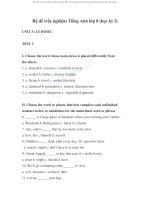3 3 2 star tracks (earth science)
Bạn đang xem bản rút gọn của tài liệu. Xem và tải ngay bản đầy đủ của tài liệu tại đây (4.17 MB, 14 trang )
Suggested levels for Guided Reading, DRA,™
Lexile,® and Reading Recovery™ are provided
in the Pearson Scott Foresman Leveling Guide.
Earth Science
Star Tracks
by Stephanie Sigue
Genre
Expository
nonfiction
Comprehension
Skills and Strategy
• Author’s Purpose
• Fact and Opinion
• Summarize
Text Features
•
•
•
•
Captions
Labels
Diagrams
Glossary
Scott Foresman Reading Street 3.3.2
ISBN 0-328-13357-4
ì<(sk$m)=bd fhe< +^-Ä-U-Ä-U
Reader Response
1. What do you think was the author’s
purpose for writing this book?
2.
Star
Tracks
Use a graphic organizer like the one
belowby
toStephanie
describe Galileo’s
Sigue contributions
to science.
Galileo’s
Key
Contributions
3. Telescope comes from the Greek word
tele, which means “far off.” Can you think
of two other words that start with tele?
Use each word in a complete sentence.
4. How did the picture on page 13 of the girl
using the sextant help you to see how a
sextant works?
Editorial Offices: Glenview, Illinois • Parsippany, New Jersey • New York, New York
Sales Offices: Needham, Massachusetts • Duluth, Georgia • Glenview, Illinois
Coppell, Texas • Ontario, California • Mesa, Arizona
Suppose you are being driven to a soccer
match, but your dad doesn’t know the way.
Today, that is not a problem. If your dad has a
modern car, its tracking device will show him
how to get there. How does this work?
Up in space a satellite transmits a signal.
When a driver types a destination into the
car’s computer, it sends the information to
the satellite. The satellite locks onto the car’s
position and sends back directions.
But what happened before there were
computers and satellites? How did people find
their way long ago? This book will explore those
questions and more as we learn about the stars
and how they help guide us.
Every effort has been made to secure permission and provide appropriate credit for
photographic material. The publisher deeply regrets any omission and pledges to
correct errors called to its attention in subsequent editions.
Unless otherwise acknowledged, all photographs are the property of Scott Foresman,
a division of Pearson Education.
Photo locators denoted as follows: Top (T), Center (C), Bottom (B), Left (L), Right (R),
Background (Bkgd)
Opener: ©DK Images; 1 ©DK Images; 3 Getty Images; 5 ©DK Images; 6 ©DK Images;
7 ©DK Images; 8 ©DK Images; 9 ©DK Images; 10 ©DK Images; 11 ©DK Images;
12 ©DK Images; 13 ©DK Images; 14 ©DK Images; 16 (TL) ©DK Images, (BR) Science &
Society Picture Library; 17 ©DK Images; 18 ©DK Images; 19 ©DK Images;
21 ©DK Images; 23 DK Images
ISBN: 0-328-13357-4
Copyright © Pearson Education, Inc.
All Rights Reserved. Printed in the United States of America. This publication is
protected by Copyright, and permission should be obtained from the publisher
prior to any prohibited reproduction, storage in a retrieval system, or transmission
in any form by any means, electronic, mechanical, photocopying, recording, or
likewise. For information regarding permission(s), write to: Permissions Department,
Scott Foresman, 1900 East Lake Avenue, Glenview, Illinois 60025.
2 3 4 5 6 7 8 9 10 V0G1 14 13 12 11 10 09 08 07 06 05
3
Viewing the Stars
Stars and the Universe
In good conditions you can see about two
thousand stars with your own eyes. With
telescopes you can see many, many more.
Telescopes make it possible to see the stars in an
entirely different way.
Stars are mostly hydrogen and helium
gas. They are different colors, sizes, and
temperatures. Their heat causes them to give off
light. As a star ages, its hydrogen runs out. When
this happens, the star expands and changes color.
Scientists measure the distances between stars
in light years. One light-year is about 6 trillion
miles! The star closest to our solar
system is 4.3 light years away.
The Sun, meanwhile, is only
93 million miles away
from Earth.
Stars usually revolve around one or two
other stars. Often a group of stars will blend
together to look like one star. Some stars travel
through space in small groups of two or three,
or in large groups of tens of millions. These
large groups of stars are called star clusters. Even
larger than star clusters are galaxies. A galaxy
may include hundreds of billions of stars.
Some galaxies have shapes you have seen
before, such as a pinwheel. Galaxies contain gas
and dust, and are held together by gravity. Our
galaxy, the Milky Way,
is made up of the
Sun, the planets,
and more than
200 billion
stars.
The Milky Way galaxy
4
5
Ursa Major
A chart showing many
of the constellations
Constellations
Constellations are groups of stars that make
up shapes in the sky. Ancient people named
them after mythological creatures, such as
unicorns. They also named constellations after
gods and heroes from stories.
Astronomers are scientists who study the
universe. They have named eighty-eight official
constellations. These constellations are known
to people all over the world. Astronomers from
very long ago believed that the Earth was the
center of the universe. They thought that the
Sun, Moon, and stars moved around it.
6
Ursa Major is one of the more well known
constellations. It contains both a very famous
star and a very famous set of stars. The famous
star is the North Star. The famous set of stars is
the Big Dipper.
A group of seven bright stars connect to
make the Big Dipper. Directly above the two
stars that make the far side of the Dipper’s
“bowl” (opposite the Dipper’s “handle”) sits the
North Star. The two stars in the bowl are called
the Pointers because they point to the North Star.
The North Star has always been the
Northern Hemisphere’s most important star for
doing celestial navigation, because it is always
found by looking north.
Big Dipper
North Star
The stars of the constellation Ursa Major
7
Leo
Orion
Orion and Leo
The constellation Orion has more bright
stars than any other. Some people think they
resemble a warrior with a club, a shield, and a
sword hanging from his belt. The belt is made
up of three bright stars in a row. They are easily
seen in the winter sky.
In spring, new constellations appear. Then
you can see five stars in the shape of a backward
question mark. They make up the head of Leo,
the lion. Regulus is the star that marks the heart
of Leo. To the left of Regulus are three stars in
the shape of a triangle. The brightest of those
three is the tail end of Leo.
8
Orion, Leo, and Regulus are just a few of
the many stars and constellations that early
explorers would have known about and used to
figure out their location.
Of all the early explorers, Christopher
Columbus is probably the most famous. He is
known both for the places he sailed to and the
different groups of people he met on his travels.
But Columbus is also very important as an
example of how early
sailors navigated using the
equipment and knowledge
that was available to
them. Read on to
find out more about
navigators like
Columbus and how
they were able to
plot a course based on
what they saw in the sky.
A statue of Christopher
Columbus
9
Early Explorers Look to the Sky
Early Explorers and Navigation
Finding your way without getting lost wasn’t
always easy. Explorers such as Columbus had
only maps and a compass to help them. They
had to rely on the Sun, the Moon, and the stars
to lead them.
During the day, early explorers depended
on the Sun. Because the Sun rises in the east,
explorers knew they were sailing south if the Sun
was rising on their left. If the Sun was rising on
their right, they knew they were sailing north.
But what did they do at night?
Think about what the ocean must have been
like at night. After the Sun went down, explorers
had only the Moon and the stars to guide them.
That’s why they looked to the stars and the
constellations for help.
A navigator is someone who charts a
ship’s position and course. All navigators need
information about time, direction, distance,
speed, and position.
Explorers like Columbus used a navigational
technique called dead reckoning. With dead
reckoning, a captain would start
sailing from a known point and
measure out each day’s
course and distance. Each
day’s ending position
would be the starting
place for the next
day’s measurement.
Navigators used a
magnetic compass
to measure the
course. They
figured the distance
they had traveled by
multiplying the ship’s
speed by the amount
of time traveled.
A 16th-century navigator
uses a cross-staff to sight
the Sun and find his
position.
Early
mariner’s
compass
10
11
Columbus and Celestial Navigation
Columbus also used celestial navigation
techniques. Celestial navigation uses the Sun,
Moon, and stars to measure latitude. Your
latitude is your distance either north or south of
the equator. Geographers draw lines of latitude
from the equator to the poles. Fifteenth-century
navigators measured latitude to help find their
location.
In Columbus’s time the quadrant was the
most important tool in celestial navigation.
Quadrants were used to measure the
distance in degrees between the
North Star and the horizon. The
reading indicated the degrees of
latitude above the equator.
This reading marked the
ship’s location.
Ocean waves make it difficult to hold a
quadrant steady. The North Star is sometimes
obscured by clouds. And the horizon can be
hard to locate at night because of darkness. All
of these things made celestial navigation difficult.
While explorers like Columbus were
figuring out better ways to navigate, scientists
were coming up with better ways to study the
stars. Keep reading to find out about the new
instruments that scientists used to prove their
theories about the heavens. You will also find out
how scientists borrowed from each other to come
up with better equipment and ideas.
Quadrant
Sextant
12
13
14
A Scientific Breakthrough
A Spyglass Becomes a Telescope
The measuring techniques used during
early expeditions were only somewhat accurate.
Usually, navigators were off by a few miles. If
bad weather prevented explorers from observing
the sky, the results were worse.
Early navigators finally got help from
three scientists: Nicolaus Copernicus, Hans
Lippershey, and Galileo Galilei. That trio’s
theories and inventions would pave the way for
space travel and exploration.
Copernicus was a Polish astronomer. He
argued that the Sun, not the Earth, was the
center of the solar system. Many people didn’t
believe him. Powerful groups challenged both
him and his theory.
It took the invention of the lens to help
prove Copernicus’s theory. No one really knows
who invented the lens. What is known is that
eyeglasses were invented during the 1200s.
It is thought that the inventor, while making
windowpanes, noticed that he could see better
while looking through them.
The spyglass was invented around 1600 by
Hans Lippershey. Lippershey, who was Dutch,
made eyeglasses. Some people believe that two
children were playing with his lenses and put two
of them together. When they looked through the
lenses at a distant church tower, it was magnified.
Lippershey supposedly used this discovery to
create the first spyglass.
News of the invention spread throughout
Europe. One of the people most interested in it
was the Italian scientist Galileo Galilei.
15
Why Galileo Is
Important
Galileo was already
well known by the time he
learned of Lippershey’s
invention. Galileo studied
Lippershey’s spyglass and
built a bigger one. Galileo’s
spyglass made objects
twenty times larger than
their actual size. It allowed him to look at things
in the nighttime sky that no one had seen before.
He saw mountains, valleys, and craters on the
Moon. He could see that the
Milky Way was made
up of billions of stars.
Galileo’s findings
were important
news, but some
people refused to
believe him.
An ink
sketch of
the Moon
by Galileo
16
Those people thought that the Moon was
smooth and that Galileo was trying to trick
them. To prove them wrong, he continued his
observations.
One night in 1610 Galileo noticed four
objects near Jupiter that no one had seen before.
The next night, he saw them again, but in a
different place.
What Galileo had discovered was Jupiter’s
moons. He was able to see that they were
traveling around the planet. Galileo also
discovered “stars” that circled the planet Saturn.
Those “stars” were later identified as Saturn’s
rings. More importantly, Galileo watched
sunlight move across the planet Venus.
This proved that Venus traveled
around the Sun, not the Earth.
Copernicus was right! The Sun,
not the Earth, was the center
of our solar system. Earth
was just another planet.
Replica of Galileo’s
telescope
17
Galileo and Newton
Later Telescopes
Galileo published his discoveries in his
book The Starry Messenger. He also began selling
his spyglasses. In 1611 a banquet was held
in Galileo’s honor. At that banquet Galileo’s
spyglass was renamed the telescope, which
combines the Greek words tele, or “far off,” and
skopos, meaning “seeing.”
Early telescopes allowed light to pass in a
straight line from the front lens to the eyepiece
at the opposite end of the tube. These telescopes
were refractive. Their front lens bent, or
refracted, light.
Seventy years later, an Englishman, Isaac
Newton, invented a new type of telescope.
Like Galileo, Newton was a scientist who was
interested in motion and force. Newton’s fame
came from his discovery of gravity, but his new
telescope was nearly as important.
Newton was interested in light and color.
That interest led him to design a reflective
telescope that used reflecting mirrors instead of
lenses. In Newton’s design a curved mirror was
angled to reflect light through a side eyepiece.
Shorter than Galileo’s, Newton’s telescope was
much easier to use. Not only that, but its images
were bigger and clearer. Astronomers would
have to wait another three hundred years for the
next big improvement in telescope design.
Refractive telescope
18
Reflective telescope
19
The Hubble Telescope
George Hale was an American from
Chicago. From the time he was sixteen until
his death in 1938, Hale worked to build
telescopes to provide large images of the Sun.
Hale eventually designed the 200-inch Palomar
telescope. George Hale was a master builder of
large telescopes.
Scientists continue to improve on telescope
design. In 1990, NASA (National Aeronautics
and Space Administration) sent a special
telescope into space, named the Hubble Space
Telescope. Its name honors the late American
astronomer Edwin Hubble. The telescope has
sent some extraordinary photographs of the stars
back to Earth.
You have now read about the stars and
constellations, and where to find some of them.
You have also read how early navigators used
the stars to find their way. Finally, you have read
how scientists used important new equipment
to make discoveries about the stars. As you can
see, people have been learning from the stars and
using them as guides for a very long time!
A drawing of the
Hubble Telescope
20
21
Now Try This
Looking into the Hubble Telescope
On page 20, you read about the Hubble
Telescope. The Hubble Telescope is one of
the most advanced telescopes ever made.
It can take photographs of objects that
are billions of light-years away.
Now, with this activity, you will be able
to find out much more about the Hubble
Telescope!
22
to Do It!
w
o
H
s
’
e
r
He
First, gather together in small classroom
groups of up to five. Then, have each
member of the group do research on one
question relating to the telescope.
Here are some good questions to
research: How does the telescope work?
How and when was it launched? Why did
it cost so much to build? What was the
problem with the telescope? What has the
telescope accomplished?
Once research on questions is complete,
individual students may present their
findings to the class. Have a notetaker
summarize everyone’s discoveries.
23
Glossary
astronomers n.
scientists who study
the solar system,
our galaxy, and the
universe.
celestial navigation n.
a way to use
heavenly, or celestial,
objects to chart a
ship’s course.
constellations n.
groups of stars
that can be seen
as patterns in the
sky. There are
eighty-eight
constellations in all.
dead reckoning n.
a method used by
early navigators to
figure out their ship’s
position.
galaxy n. a large
collection of stars,
gas, and dust held
together by gravity.
24
Reader Response
latitude n. a thing’s
distance north or
south of the Earth’s
equator.
light-year n. the
distance a beam of
light travels through
space in a year.
1. What do you think was the author’s
purpose for writing this book?
2. Use a graphic organizer like the one
below to describe Galileo’s contributions
to science.
quadrant n. an
instrument used in
Columbus’s time to
measure the distance
between the North
Star and the horizon.
Galileo’s
Key
Contributions
refractive adj. when
something causes
light to be bent.
3. Telescope comes from the Greek word
tele, which means “far off.” Can you think
of two other words that start with tele?
Use each word in a complete sentence.
telescope n. an
instrument that
makes faraway
objects seem nearer.
Telescopes are often
used to look at the
objects in the solar
system.
4. How did the picture on page 13 of the girl
using the sextant help you to see how a
sextant works?









